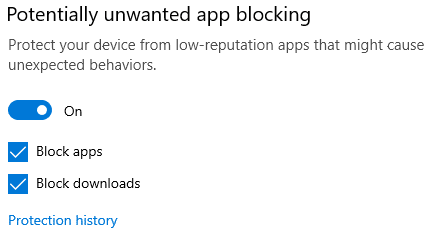

Setting the value for this cmdlet to disabled will turn the feature OFF if it has been enabled.Setting the value for this cmdlet to Enabled will turn the feature ON if it has been disabled.What is PUA/PUP? How to turn on Windows Defender PUA/PUP protection in Windows 10 Home and Windows 10 Pro? Method 1, Use PowerShell cmdlets to configure the PUA protection featureģ, Right-click on Windows PowerShell, and click Run as administrator.ĥ, Restart the system, and then the PUA detection will be enabled. But, it has been turned off by default in Windows 10 Home and Windows 10 Pro.

Maybe your relatives and friends will no longer bother you with requests to fix their slow PCs full of banners and registry cleaners.For improving Windows 10 enterprise security, Microsoft turned on PUA/PUP protection of Windows Defender by default.

New policies will help less-proficient users avoid adware and other potentially harmful apps that slow down computers and cause a bad user experience. It is good to see Microsoft finally enabling PUA protection by default for all users. You can learn how to turn off potentially unwanted app protection in Microsoft Defender in a dedicated post. Because PUA by definition includes some apps that users might consider safe and useful (crypto miners, torrent clients, bundled software), Microsoft allows whitelisting specific programs to prevent false positives. In other words, PUA is any app that you would not install on your system intentionally, hence the name " unwanted apps." Besides detecting unwanted apps on your system, Microsoft Defender can spot and remove downloads that contain PUAs.Īlthough Microsoft has already enabled potentially unwanted apps protection in Microsoft Defender, users have an option to disable it (there are separate controls for apps and downloads in Edge). According to Microsoft, potentially unwanted apps are programs that slow down your computer, inject ads, install additional annoying software, crypto miners, etc. Potentially unwanted apps (PUA) are not necessarily malware because they do not cause direct harm to your system or files as, for example, ransomware does. Now Microsoft announced that it is enabling potentially unwanted app protection for Windows 10, Windows 11, and Microsoft Edge users. Microsoft kept that setting off by default, allowing users to decide whether to use it or not. Windows Update, also known as Windows 10 2004, introduced a new potentially unwanted app protection in Microsoft Defender. RЕCOMMENDED: Click here to fix Windоws issues and optimize system performance


 0 kommentar(er)
0 kommentar(er)
